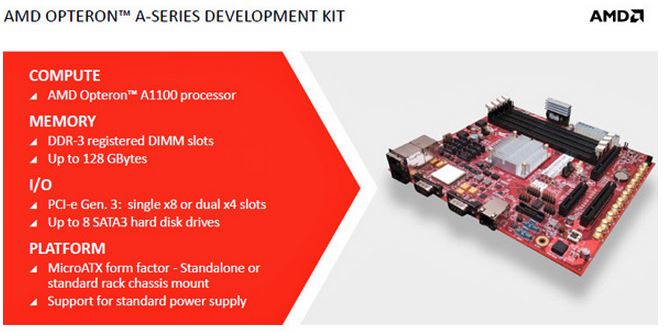AMD finally announced the chip it previewed a few weeks ago. The AMD Opteron A1100 processor is a significant leap by AMD into the server market, one that it has largely abandoned at the higher-end. With the “big core” x86 hardware significantly behind Intel in terms of performance and power consumption (AMD is mainly competing on price), AMD had previously announced a focus on the low end of the market.
For those wondering, here is a quick comparison of the AMD Opteron A1100 to the Intel Atom C2750:
[table id=1 /]
One can certainly see that AMD is bringing some serious upgrades to the system beyond the ARM cores. In effect, AMD is betting that CPU is less important and capabilities such as RAM capacity, storage connectivity and network connectivity.

One major point here, of course, is that the Intel Atom C2750 has been shipping since September 2013 which is when we published the first independent benchmarks of the Avoton platform. AMD is promising that the A1100 will be shipping in development kits in March 2014 and with volume server shipments in the fourth quarter of 2014 (October – December.) Since the Intel Atom S1260 was introduced in December 2012 and the Atom C2000 was introduced in September 2014, there is a good chance that Intel will be shipping a next generation part by the the the AMD Opteron A1100 hits the market.

AMD mentions that it believes that ARM will take 25% of server market share in 2019. AMD also says it will be a leader in that 25%.

Frankly, Intel needs some competition. One reason AMD and other ARM vendors may sell quite a few chips to Facebook, Google, and others is simple: those companies need a competitor to Intel to ensure Intel cannot price x86 too high. With AMD’s market share in the x86 server market dwindling, Intel’s newest chips have started to cost more with each successive generation without a serious competitor. Seattle is not likely to make a dent in the market, but if AMD can bring HSA to the server ARM world quickly, that may change in subsequent generations.





You’ve missed the most important point about the A1100: COST. At an estimated $100 each, Intel parts pale by comparison.
The Avoton 8-core SoC has a suggested retail price of $171 (of course “cost” to OEMs and big customers is much lower.) The Atom C2550 is about half that.
AMD needs to use a larger process node at TSMC (TSMC needs to turn a profit). AMD needs to pay ARM license fees. In a pricing war it will be hard for AMD to win.
Intel’s FinFET 22nm process used in the Avoton is much much more expensive that the 28nm bulk process at Global Foundries, in that sense AMD actually has the cost advantage. Intel has little scope to discount their part. AMD has arguably the better offering at probably half the price.
Intel can’t win this game with x86, it’s already stretching it and using its process advantage but the arch will sink it in the end. ARM is open and preferred because the industry is sick of Intel’s pricing and proprietary model. They want multiple vendors and competition.
This is what happens to monopolists, they go the way of the dinosaur.